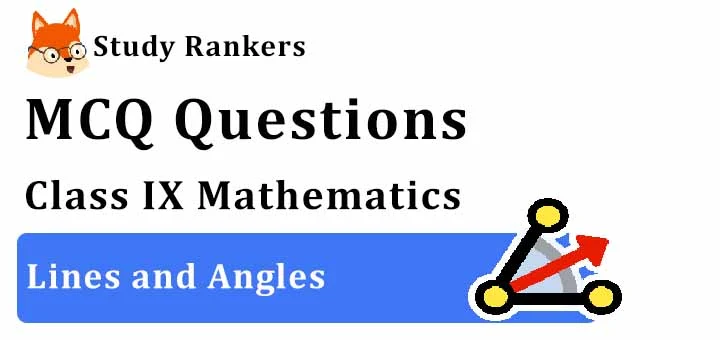MCQ Questions for Class 9 Maths: Ch 6 Lines and Angles

1. Two parallel lines intersect at:
(a) One point
(b) Two points
(c) Three points
(d) Null
► d) Null
2. If two lines intersect each other, then the vertically opposite angles are:
(a) Equal
(b) Unequal
(c) Cannot be determined
(d) None of the above
► a) Equal
3. An acute angle is:
(a) More than 90 degrees
(b) Less than 90 degrees
(c) Equal to 90 degrees
(d) Equal to 180 degrees
► b) Less than 90 degrees
4. Two lines are parallel to each other, only when
(a) They do not intersect each other when extended on either side
(b) The lines lie on the same plane
(c) They are parallel to the plane in which they lie
(d) Their point of intersection is a unique point
► (a) They do not intersect each other when extended on either side
5. The angles of a triangle are in the ratio 2 : 3 : 4. The angles, in order, are :
(a) 80°, 40°, 60°
(b) 20°, 60°, 80°
(c) 40°, 60°, 80°
(d) 60°, 40°, 80°
► (c) 40°, 60°, 80°
6. X lies in the interior of ∠BAC. If ∠BAC = 70° and ∠BAX = 42° then ∠XAC =?
(a) 28°
(b) 29°
(c) 27°
(d) 30°
► (a) 28°
7. The bisectors of the base angles of an isosceles triangle ABC, with AB = AC, meet at O. If ∠B = ∠C = 50°. What is the measure of angle O?
(a) 120°
(b) 130°
(c) 80°
(d) 150°
► (b) 130°
8. Find the measure of the angle which is complement of itself.
(a) 30°
(b) 90°
(c) 45°
(d) 180°
► (c) 45°
9. If two parallel lines are cut by a transversal, then the pairs of corresponding angles are congruent.
(a) Equal
(b) Complementary
(c) Supplementary
(d) corresponding
► (d) corresponding
10. An angle is 14° more than its complementary angle, then angle is :
(a) 38°
(b) 52°
(c) 50°
(d) None of these
► (b) 52°
11. Sum of the measure of an angle and its vertically opposite angle is always.
(a) Zero
(b) Thrice the measure of the original angle
(c) Double the measure of the original angle
(d) Equal to the measure of the original angle
► (c) Double the measure of the original angle
12. Two angles whose measures are a & b are such that 2a - 3b = 60° then 5b = ?, if they form a linear pair:
(a) 120°
(b) 300°
(c) 60°
(d) None of these
► (b) 300°
13. How many degrees are there in an angle which equals one-fifth of its supplement?
(a) 15°
(b) 30°
(c) 75°
(d) 150°
► (b) 30°
14. If two straight lines are perpendicular to a line l, then they are.
(a) The lines intersect each other when extended
(b) Parallel to each other
(c) The angle between the two lines is 180°
(d) Perpendicular to each other
► (b) Parallel to each other
15. If one angle of triangle is equal to the sum of the other two angles then triangle is :
(a) Acute triangle
(b) Obtuse triangle
(c) Right triangle
(d) None of these
► (c) Right triangle
16. If a side of a triangle is produced, then the exterior angle so formed is equal to the sum of the ____ interior opposite angles.
(a) Two
(b) Four
(c) One
(d) Three
► (a) Two
17. Given four points such that no three of them are collinear, then the number of lines that can be drawn through them are:
(a) 4 lines
(b) 8 lines
(c) 6 lines
(d) 2 lines
► (c) 6 lines
18. Two parallel lines have:
(a) A common point
(b) Two common points
(c) No common point
(d) Infinite common points
► (c) No common point
19. In a triangle ABC if ∠A = 53° and ∠C = 44° then the value of ∠B is:
(a) 46°
(b) 83°
(c) 93°
(d) 73°
► (b) 83°
20. Which of the following statements is false?
(a) A line can be produced to any desired length.
(b) Through a given point, only one straight line can be drawn.
(c) Through two given points, it is possible to draw one and only one straight line
(d) Two straight lines can intersect in only one point
► (b) Through a given point, only one straight line can be drawn.
21. In a right-angled triangle where angle A = 90° and AB = AC. What are the values of angle B?
(a) 45°
(b) 35°
(c) 75°
(d) 65°
► (a) 45°
22. The angle between the bisectors of two adjacent supplementary angles is :
(a) Acute angle
(b) Right angle
(c) Obtuse angle
(d) None of these
► (b) Right angle
